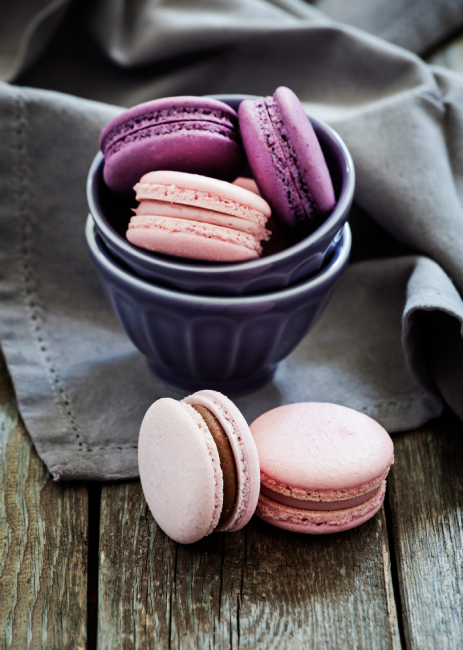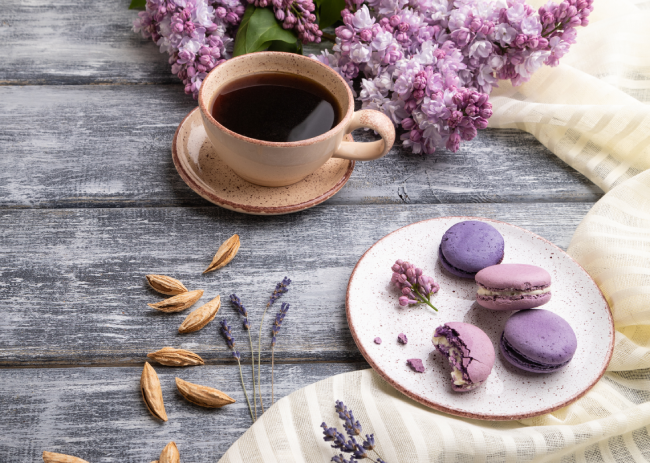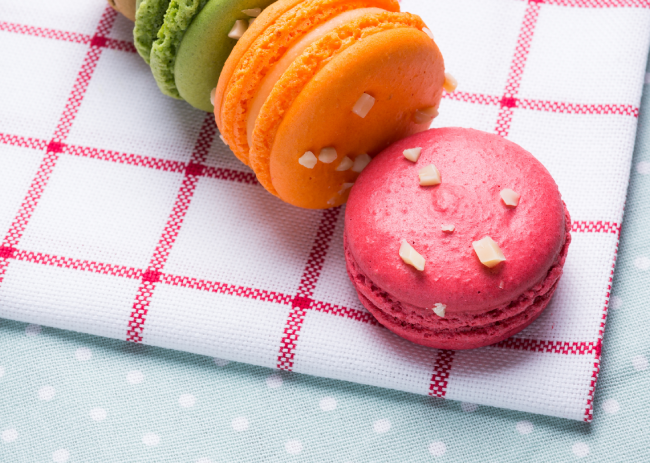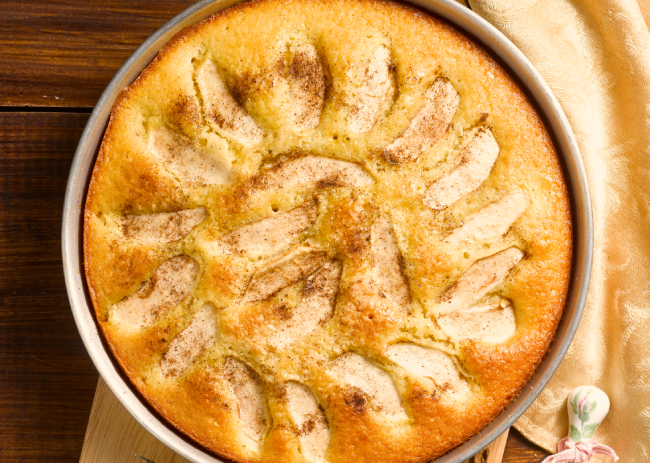How To Make The Perfect Vegan Macarons
Have you ever had a macaron? Macarons are a delicious dessert, one that pretty much anyone can’t turn down. They can be decorative and colourful. And, they can be creamy on the inside. Who wouldn’t want a macaron? The only problem is, that they aren’t vegan-friendly in their normal form. (Yes, vegans love to enjoy desserts too!) Macarons tend to contain ingredients like confectioners’ sugar, which aren’t vegan-friendly. But did you know that you can make vegan-friendly macarons? No kidding! The recipe is so good, that even non-vegans will love them too. This post will delight you with a fantastic recipe that’ll have you making your own vegan macarons today. Here’s how to make them and have the tastiest macarons around.
What Are Vegan Macarons?
Okay, so firstly, what is a vegan macaron? A macaron is a sweet cookie, made from meringue and almond flour. The regular macaron isn’t vegan as the meringue is traditionally made using egg whites and sugar. Of course, eggs aren’t vegan, so you’ll need to find a way to replace them in the recipe.
That’s where aquafaba comes in. In a vegan macaron, this works much better. Aquafaba (or chickpea-stewed water) is gelatinous while still being vegan, so is perfect for creating a vegan version of this dessert.
It’s important to note that a macaron is not a macaroon. They’re very similar cookies, but while a macaron is mixed with almond flour, a macaroon is mixed with shredded coconut. They’re also dipped in, or drizzled with chocolate, which you don’t often do with macarons.
How Did Vegan Macarons Originate?
So where did vegan macarons come from? There doesn’t appear to be anyone who can answer that question. While macarons have been around forever, the rise in people becoming vegan has led to multiple recipes being made.
That’s something that drove many would-be bakers to create their very own vegan version of macarons. To be fair, it’s something that’s still being tweaked right now. So, what constitutes the perfect vegan macaron? Well, as people try and create the perfect macaron, we might never know.
However, this recipe will give you the best up-to-date version that you’ll be able to enjoy.
Health Benefits Of Eating Vegan Macarons
A regular macaron isn’t a healthy food, sure, but a freshly baked one isn’t going to be full of preservatives and other things that you’d find in a store-bought cookie. The same can be said of vegan versions, too.
Many people go vegan because they have an intolerance to eggs or dairy. That’s something that stops them from enjoying their favourite snacks, including macarons. They aren’t able to eat them, as they would have an allergic reaction. When they have access to vegan macarons, that allows them to have a better snack that won’t cause a reaction and potentially endanger their health. Plus, it satisfies that craving that many people have for something sweet.
There are lots of health benefits to going vegan in general, and eating a vegan version of macarons can help you stick to that diet. You will be able to get a better source of certain nutrients, lose weight, lower blood sugar levels, and more. Of course, that still means that you have to enjoy these macarons in moderation, just as you would with any other sweet treat.
Ingredients Required To Make Vegan Macarons
The truth is, you don’t need an awful lot of know-how, let alone a lot of ingredients and tools, in order to make your macarons. Essentially, the most “work” that you’ll do will be making your macarons as unique and creative as possible. In other words, the “work” turns into fun, as you bake.
At a basic level, all you really need is almonds, sugar and egg whites. Everything else – like powdered sugar, regular sugar, aquafaba (which we will discuss further), cream of tartar, vinegar, food colour, and almond flour – is used to help you get consistent results.
As for the aquafaba, it’s the cooking liquid from beans or chickpeas. Typically, the liquid from a can of chickpeas will give you what you need. So, there’s no need to make the aquafaba from scratch (unless you want to).
Need more convincing? Here are the typical nutritional facts about vegan macarons:
- 149 calories per serving (1 macaron)
- 73 calories from fat
- 8.1g total fat
- 16mg sodium
- 10g sugar
- 0.8g protein
Equipment Required
Also, consider the equipment you’re going to need. Consider gathering your equipment, so that you have them all in one place. Besides having an oven and stovetop to work with, you’ll also need these other tools and equipment:
- Whisk mixe
- Working scale
- Mixing bowl
- Good sieve
- Spatula (preferably silicone)
- Saucepan (preferably small)
- Food thermometer
- Piping bags
Again, be sure that you keep these things handy as you cook. That’s because you’ll be working quickly, and you’ll be multitasking with the recipe.
Other requirements
Besides ingredients and tools, you’ll also need to take heed of the following requirements:
- Your ideal prep time is 30 minutes.
- Your ideal baking time is around 20 minutes (or until the macarons form “feet”).
- The recipe should make around 30 macarons.
Tips To Make Vegan Macarons
So now, if you’ve never made vegan macarons before, then not to worry! Here are some tips that are worth knowing before you get started:
- Don’t worry if they don’t come out right: Macarons are notoriously tricky to make, and even if you do everything right, they might not come out the way you want. Like everything else in life, it’s not going to be perfect. If you don’t get the best results the first time, don’t be discouraged. Even with this recipe, you may not get them the way you want on the first try, so you’ll want to try them again. Besides, that’s the fun of making macarons, and cooking in general!
- Always sift: While it’s tempting to skip sifting the sugar and flour to save time, don’t do it. Always make sure that you sift the ingredients. Sifting prevents lumps from remaining in the batter. A smooth batter is essential to a good macaron shell.
- Don’t bake directly on the baking sheet: You may have success with baking other goods directly on the baking sheet, but it won’t work with vegan macarons. They need a non-stick surface and an evenly distributed heat. You can get this by using a silicone baking mat, or two sheets of parchment paper.
- Use clean equipment: It’s so important that all your equipment is squeaky clean before you start baking. Any water or grease in the bowl or on the whisk will stop the aquafaba from forming stiff peaks. Clean everything out thoroughly before you start baking.
- Get rid of air bubbles: Air bubbles are another enemy to be conquered when getting the perfect macaron batter. Get the bubbles out as you mix it, and push down on your piping bag as you squeeze the batter out. After all the shells have been piped, tap the banking tray on the table to remove any air.
- Freeze your macarons: Finally, once you’ve made your vegan macarons, you’ll want to freeze them overnight. Don’t worry about the shells hardening; that’s part of the process. Freezing allows you to get the perfect chewy texture. With that said, don’t be tempted to eat them right away, or else you’ll end up with a sticky mess.
Based on these tips alone, as you can see, there’s not much headache in following them. In fact, many of these tips can be done using common sense.
Vegan Macarons Recipe
Okay, let’s not prolong this any further! If you’re itching to make vegan macarons now, then you’re in luck! You’re now ready to start making macarons that speak volumes! Again, the recipe is simple, so there’s no need to go above and beyond.
Here’s how to make your vegan macarons, and get the best results:
- Reduce the aquafaba: Firstly, drain out your chickpeas if you’re using a canned variety, and pour the liquid into a saucepan. Simmer on low heat to reduce the liquid. Don’t worry if it doesn’t look gelatinous. Once you’re done, you can refrigerate any leftovers.
- Wash your mixing bowl and whisk: The last thing you want is to work with an unwashed bowl and a whisk with yesterday’s pancake batter and residue. While this tip is a no-brainer, many people forget to clean their equipment thoroughly before baking something.
- Therefore, always wash your bowl and whisk thoroughly in hot soapy water, and then dry them off with a paper towel.
- Grab your ingredients: Now, it’s time to get everything together. It’s important to have your ingredients on hand, so that you can move quickly when baking.
Ingredients Required
Having said that, for the macaron recipe, you’ll need the following:
- 150g aquafaba (reduced)
- 200g of granulated sugar
- ¼ cup water
- 200g of powdered sugar
- 200g of almond flour
- ¼ tsp of cream of tartar (or substitute with 1 tsp vinegar)
Again, keep in mind: You’ll be grabbing these ingredients as you mix them.
Directions
Preheat the oven: The oven should be on standby, since you’ll be working with sensitive batter. Now, if you’re using silicone mats, the oven needs to be 310 F. Or, with parchment paper, the oven needs to be at 300 F. Having your oven at the wrong temperature can cause a fire hazard, let alone have your macarons come out wrong.
Tackle the fluff: Now, let’s add 75 grams of the reduced aquafaba. Afterwards, mix in the cream of tartar (or vinegar). Adjust your mixer to medium high speed. Once you raise the whisk, the mixture should form little peaks that fall over.
Heat your sugar: Add the granulated sugar to a saucepan with ¼ cup of water. Afterwards, put it on low heat (medium), and don’t stir. As you heat the sugar, you’ll need to make sure that you get a temperature of 245 F. So, use the thermometer to get the sugar up to 245 F.
Tackle the dry ingredients: While waiting on the fluff and sugar, measure 200 grams of powdered sugar, and then do the same with the 200 grams of almond flour. Then, add the dry ingredients through the sieve, and into the mixing bowl.
Mix the sugar and the fluff: Once the sugar’s temperature reaches 245 F, pour it slowly into the continuously-mixing fluff. Keep mixing until the outside of the bowl cools down, and the mixture comes out glossy and sticky.
NOTE: Be careful when handling the bowl. You don’t want to burn yourself. That’s why it’s imperative that you let the bowl cool down.
Make your marzipan: Take the rest of the aquafaba, and pour it in with your dry ingredients. As you combine both bowls, do it slowly. This allows for the aquafaba to blend in well with the other ingredients.
Mix it all up: Once your aquafaba is blended into the mixture, you can then add about half of your meringue to your marzipan. But remember: Don’t grab any candied sugar from the edges or margins as you do so. Keep mixing the batter until you can’t see any chunks left. Leftover chunks can make your macarons turn out rocky or misshaped.
Start the macaronage: Macaronage is when you fold the meringue into your almond mixture. This, in turn, knocks out the air and creates perfect vegan macarons. Add the rest of the meringue into the mix, and tilt the bowl ¾ on its side, which will help fold the mix. Now, using your spatula, scrape the mixture from the bowl. Start along the top of the bowl. Next, go around the bottom. And then, make your way back up the opposite side. Keep doing it until the batter becomes thick. Add your favourite food colouring, if desired. Soon, you’ll be able to draw a figure 8 with the batter. If your figure 8 is easy to do, that means that the batter is ready.
Pipe your shells: Now, you’re ready to make the shells. Here, you’ll use a tall glass to line your piping bag. Once lined up, you can fill the bag. When filled, pipe the mixture perpendicular to your baking tray. Squeeze until you’ve made a diameter-wide circle. Next, immediately ice the macaron.
Pop the bubbles: To get rid of any air bubbles, grab the tray, and smack it firmly against the countertop. Use a toothpick to pop them, if necessary. Don’t worry about how you pop them – the goal is to make your macarons look less “bubbly.”
Allow the skin to form: After ridding your macarons of any bubbles, set the tray on a flat surface. Then, let the tray sit until the shells are no longer shiny or sticky.
Bake your shells: Now, put the macaron shells in the oven for 20 minutes. You should see them form ‘feet’ during the 6- or 7-minute mark. After 20 minutes, they should be dry.
Fill your shells: Once you’ve removed the shells from the oven and let them cool, they should peel off easily from the mat or paper. Then, fill them with whatever you want:
- Buttercream
- Cookie butter
- Ganache, OR
- Your favourite jam (Any flavour!)

Vegan Macarons Recipe
Ingredients
- 150 g aquafaba reduced
- 200 g granulated sugar
- ¼ cup water
- 200 g powdered sugar
- 200 g almond flour
- ¼ tsp cream of tartar or substitute with 1 tsp vinegar
Instructions
- Reduce the aquafaba: Firstly, drain out your chickpeas if you’re using a canned variety, and pour the liquid into a saucepan. Simmer on low heat to reduce the liquid. Don’t worry if it doesn’t look gelatinous. Once you’re done, you can refrigerate any leftovers.
- Wash your mixing bowl and whisk: The last thing you want is to work with an unwashed bowl and a whisk with yesterday’s pancake batter and residue. While this tip is a no-brainer, many people forget to clean their equipment thoroughly before baking something.
- Therefore, always wash your bowl and whisk thoroughly in hot soapy water, and then dry them off with a paper towel.
- Grab your ingredients: Now, it’s time to get everything together. It’s important to have your ingredients on hand, so that you can move quickly when baking.
- Preheat the oven: The oven should be on standby, since you’ll be working with sensitive batter. Now, if you’re using silicone mats, the oven needs to be 310 F. Or, with parchment paper, the oven needs to be at 300 F. Having your oven at the wrong temperature can cause a fire hazard, let alone have your macarons come out wrong.
- Tackle the fluff: Now, let’s add 75 grams of the reduced aquafaba. Afterwards, mix in the cream of tartar (or vinegar). Adjust your mixer to medium high speed. Once you raise the whisk, the mixture should form little peaks that fall over.
- Heat your sugar: Add the granulated sugar to a saucepan with ¼ cup of water. Afterwards, put it on low heat (medium), and don’t stir. As you heat the sugar, you’ll need to make sure that you get a temperature of 245 F. So, use the thermometer to get the sugar up to 245 F.
- Tackle the dry ingredients: While waiting on the fluff and sugar, measure 200 grams of powdered sugar, and then do the same with the 200 grams of almond flour. Then, add the dry ingredients through the sieve, and into the mixing bowl.
- Mix the sugar and the fluff: Once the sugar’s temperature reaches 245 F, pour it slowly into the continuously-mixing fluff. Keep mixing until the outside of the bowl cools down, and the mixture comes out glossy and sticky.
- NOTE: Be careful when handling the bowl. You don’t want to burn yourself. That’s why it’s imperative that you let the bowl cool down.
- Make your marzipan: Take the rest of the aquafaba, and pour it in with your dry ingredients. As you combine both bowls, do it slowly. This allows for the aquafaba to blend in well with the other ingredients.
- Mix it all up: Once your aquafaba is blended into the mixture, you can then add about half of your meringue to your marzipan. But remember: Don’t grab any candied sugar from the edges or margins as you do so. Keep mixing the batter until you can’t see any chunks left. Leftover chunks can make your macarons turn out rocky or misshaped.
- Start the macaronage: Macaronage is when you fold the meringue into your almond mixture. This, in turn, knocks out the air and creates perfect vegan macarons. Add the rest of the meringue into the mix, and tilt the bowl ¾ on its side, which will help fold the mix. Now, using your spatula, scrape the mixture from the bowl. Start along the top of the bowl. Next, go around the bottom. And then, make your way back up the opposite side. Keep doing it until the batter becomes thick. Add your favourite food colouring, if desired. Soon, you’ll be able to draw a figure 8 with the batter. If your figure 8 is easy to do, that means that the batter is ready.
- Pipe your shells: Now, you’re ready to make the shells. Here, you’ll use a tall glass to line your piping bag. Once lined up, you can fill the bag. When filled, pipe the mixture perpendicular to your baking tray. Squeeze until you’ve made a diameter-wide circle. Next, immediately ice the macaron.
- Pop the bubbles: To get rid of any air bubbles, grab the tray, and smack it firmly against the countertop. Use a toothpick to pop them, if necessary. Don’t worry about how you pop them – the goal is to make your macarons look less “bubbly.”
- Allow the skin to form: After ridding your macarons of any bubbles, set the tray on a flat surface. Then, let the tray sit until the shells are no longer shiny or sticky.
- Bake your shells: Now, put the macaron shells in the oven for 20 minutes. You should see them form ‘feet’ during the 6- or 7-minute mark. After 20 minutes, they should be dry.
- Fill your shells: Once you’ve removed the shells from the oven and let them cool, they should peel off easily from the mat or paper. Then, fill them with whatever you want:Buttercream, Cookie butter, Ganache, OR Your favourite jam (Any flavour!)
Notes
- Don’t worry if they don’t come out right: Macarons are notoriously tricky to make, and even if you do everything right, they might not come out the way you want. Like everything else in life, it’s not going to be perfect. If you don’t get the best results the first time, don’t be discouraged. Even with this recipe, you may not get them the way you want on the first try, so you’ll want to try them again. Besides, that’s the fun of making macarons, and cooking in general!
- Always sift: While it’s tempting to skip sifting the sugar and flour to save time, don’t do it. Always make sure that you sift the ingredients. Sifting prevents lumps from remaining in the batter. A smooth batter is essential to a good macaron shell.
- Don’t bake directly on the baking sheet: You may have success with baking other goods directly on the baking sheet, but it won’t work with vegan macarons. They need a non-stick surface and an evenly distributed heat. You can get this by using a silicone baking mat, or two sheets of parchment paper.
- Use clean equipment: It’s so important that all your equipment is squeaky clean before you start baking. Any water or grease in the bowl or on the whisk will stop the aquafaba from forming stiff peaks. Clean everything out thoroughly before you start baking.
- Get rid of air bubbles: Air bubbles are another enemy to be conquered when getting the perfect macaron batter. Get the bubbles out as you mix it, and push down on your piping bag as you squeeze the batter out. After all the shells have been piped, tap the banking tray on the table to remove any air.
- Freeze your macarons: Finally, once you’ve made your vegan macarons, you’ll want to freeze them overnight. Don’t worry about the shells hardening; that’s part of the process. Freezing allows you to get the perfect chewy texture. With that said, don’t be tempted to eat them right away, or else you’ll end up with a sticky mess.
FAQs
Still not sure how to go about making vegan macarons? Then don’t panic! Here are some of the most frequently asked questions that readers have asked:
What Are Vegan Macarons Made Of?
Typically, a vegan macaron will use aquafaba, the cooking liquid from chickpeas, instead of egg whites. Along with this, they use almond flour, sugar, water, and cream of tartar. As such, they will be almost identical to regular macarons once they’ve been made.
Can Vegans Eat Macarons?
Vegans can’t eat regular macarons, as they use egg whites. As eggs are an animal product, it makes the dessert not vegan friendly. That’s why vegan macarons have been developed, so vegans can enjoy this treat without using animal products in the baking process.
What Are Eggless Macarons Made Of?
Eggless macarons are made of almond flour, sugar, water, cream of tartar, and aquafaba. Aquafaba is the cooking liquid for chickpeas, and it replaces the egg when making the meringue for vegan macarons.
Can You Substitute Almond Flour in Macarons?
Typically, almond flour is one of the vital ingredients when it comes to macarons, whether you’re making regular or vegan macarons. However, you can substitute it if you so wish. Pumpkin seeds can be used, especially if you grind them to make your own flour. You can also use all-purpose flour, although you may need some more egg or binding agents to do so.
How Do I Reduce Aquafaba?
To reduce aquafaba, place it in a saucepan and heat it over the stove on low heat. Let the mixture simmer until it lowers by about a third.
Why Are Macarons Not Vegan?
Macarons aren’t vegan as they use egg whites. As eggs are an animal product, this makes macarons not vegan friendly. You can make vegan macarons by simply replacing the egg whites with aquafaba, which gives you the same properties needed to create these cookies.
Do Macarons Have Gelatin?
You may already know that macarons aren’t vegan friendly, but why is that? It’s easy to assume that’s because they contain gelatin, which is an animal by-product. The actual reason they aren’t vegan is that they use egg whites. As eggs are an animal product, then you’ll see that they can’t be eaten by vegans. Luckily, it’s quite easy to make vegan macarons, by changing out the egg whites for aquafaba. That makes them perfectly vegan and just as delicious.
The Takeaway
So, as you’ve seen it’s not a simple process to create macarons, vegan or otherwise. It’s a complicated process, and sometimes it just doesn’t go right. However, it’s so worth it to persevere, as they are so delicious when you get them right.
Making vegan macarons is possible, with just one swap from egg whites to aquafaba. It’s not even difficult to prepare the aquafaba, as you just need to reduce it on the stove. Once you’ve mastered this, you can make macarons that everyone can enjoy.
This recipe will help you make vegan macarons with the minimum amount of fuss and stress, resulting in delicious cookies. Once you’ve got the hang of them, you can try making them in different colours, decorating them, and more. Why not give them a try yourself?
Also, read: 4 Great Chocolate Dessert Recipes
Sara Sparrow is a food writer at Write my essay, where she covers vegan cooking and recipes.






Never thought of vegan macarons, looks tasty.
Great knowledge about macarons, keep sharing such recipes. It really different one- veg macarons.
They looks so tempting😋 soo delicious😘.. Yummy recipe 👌
Wow you are very detailed in the steps. Gotta try this💕
It really different one- veg macarons👍🥰
Vegan Macrons, have never thought of this! Looks yumm!
Vegan macarons never heard of this but they are tasty and healthy 😋
Indian spices are best!! ❤
Amazing recipe with easily available ingredients.😋
Perfect way to end the day with this beautiful macarons
Vegan macarons; such a unique idea! Loved the recipe!
very nice idea!
It’s gonna be a superb dessert now for vegans as well😁
The smell of fresh macaron is just invigorating.😍🤤
Vegan Macarons giving me a sweet tooth!
i like this recipe
Macarons can be vegan?😯 Thanks for this recipe!!
Looks heavenly
Sweet tooth 😋🥰
Never knew macarons weren’t vegan friendly. Personally, not a vegan but I’m tempted to taste one.
I like the vegan twist
its good and tasty dessert.
Very delicious
A great vegan alternative!
nice one
looks yummy! eager to try and eat by me. vegan macaron is a different kind of sweet, would enjoy making this one. thank you for sharing an easy method to make this at home.
looks delicious
waiting to see more recipe for these food.
nice recipe!
Indian spices are best.
I cannot even espresso my feelings for this. this is so yummy
look so charming
I love macarons and this recipe looks so much simpler to make!
Macarons ….…😍 they are so delicious..!
I tried this and its too delicious ……😍
Vegan and absolutely amazing!!
I love the macarons. you made the Perfect Vegan Macarons…so amazing and delicious.
amazing
Being a Vegan, i just am amazed at this recipe.
its good and tasty dessert.
Wondering if macrons could be made eggless. But you showed that it can be made…. Just don’t knkw how to express my happiness after finding this recipe….
Perfect vegan macrons, looks amazing
these look so appetizing!
it was just make vegans love moree
your blog is amazing!
Waiting for more vegan recipes
Looks delicious and amazing 😋😋👌👌
The Perfect Vegan Macarons is perfect for everyone’s snack item.
yummy and amazing
Vegan Macarons!!!!! sooo good
vegan macrons are so amazing
Thought macroons can’t be made vegetarian… but this recipe broke it….
MACRONS ARE ALWAYS MY FAVOURITE!
I have always loved macrons. i love this receipe.
VEGAN MACRONS LOOKS SUPER TASTY
Can’t imagine macarons without egg so definitely a must try
The simplest recipes are the best ones, I love it
This looks really delicious. Must try once at home.
Amazing…..
VEGAN macaroons ?!? So tempted to try this one out
nvr tasted it… but i want to
tastyyyyyy….
Amazing recipe of vegan macarons.. Must try
Sooooooooo Tempting…..
I want to definitely try this😊
Perfect vegan macrons aree super delicious
lovely macrons, gonna try out soon
SO flavory!!
Hi! This recipe is unique and I try this macarons recipe delicious in taste and yummy dessert. I love this vegan macarons recipe. Thank you!
its a macarontastic blog
Love and macarons are all you need.
LOVED THESE!!
Count Memories, not calories.
Love MACARONS
Vegan macarons…woah…I am gonna try this recipe to surprise my vegan friends…hope they like it…. thanks for the recipe…
So flavoury
outstanding !!1
best vegan macrons evr tired.
vegan dessert are my fav! delicious and yummy thanks for sharing!
Perfect vegan Macarons!loved it!
Delighted!!!……….
Yummy ,tasty ,healthy!
So unique and yummy
I love these macaroons!!!!!
Super
very tasty and yumm
Good
Delicious
Great Recipe!! I have a little interest in cooking, but I knew I had to try this recipe the moment I saw it!
I’m not a fan of complicated recipes, but this one was a breeze.
After trying this recipe, I can’t wait to make it again and share it with friends and family.
Literal love this page for sharing such a yummy recipe